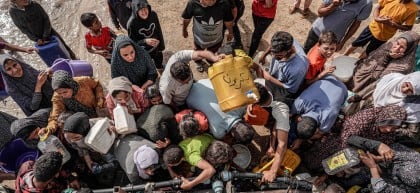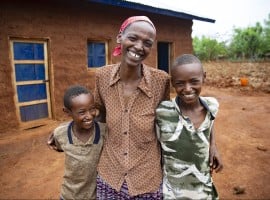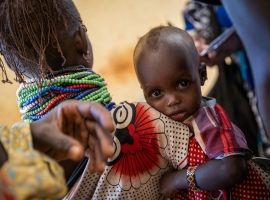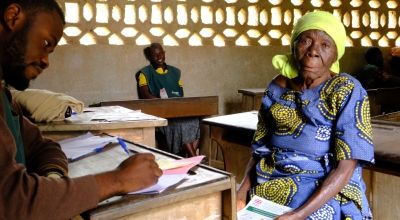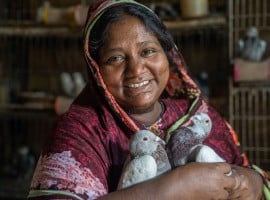
Read our 2024 annual report

Knowledge Hub
The Democratic Republic of the Congo crisis, explained
Here are five things you need to know about what's happening in the DRC in 2025.

For decades, one of the world’s deadliest, longest-running crises has been unfolding in the Democratic Republic of the Congo. Until recently, however, you probably haven’t heard much about it.
The DRC was the site for one of the worst-ever civil wars in African histories, one that shifted from national conflict in the late 1990s to localised violence. In recent weeks, however, the escalation of violence in the east has spread and threatens to grow even further. Volker Türk, the UN’s High Commissioner for Human Rights, warned at the beginning of February that “the worst may be yet to come,” shortly after the fighting had reached Goma, a major city that also serves as the capital for the eastern province of North Kivu.
These events have worsened what had already been one of the worst humanitarian crises in the world. Here are five things you need to know about the Democratic Republic of the Congo’s crisis in 2025.
1. Decades of crisis and conflict have led to a breaking point
The DRC has endured decades of multiple, overlapping crises, the roots of which stretch back centuries. In particular, the country has struggled since gaining independence from Belgium in 1960. The 36-year reign of dictator Mobutu Sese Seko ended during the First Congo War (1996-97) with his deposal. His successor, Laurent-Désiré Kabila, was assassinated during the Second Congo War (1998-2003). The 2019 inauguration of President Félix Tshisekedi — who succeeded Kabila’s son, Joseph — marked the first peaceful transition of power in the country in over half a century.
However, that peaceful transfer doesn’t mean peace across the board. Since the end of the Second Congo War, regional violence between armed groups and government forces has uprooted millions of Congolese. That led to a full-scale conflict in the Kasaï province, displacing more than 1.4 million civilians. Violence also escalated in the eastern provinces (particularly North and South Kivu) beginning in 2022 and continued into this year. “This is not business as usual in the DRC,” Antoine Sagot-Priez, Country Director for Concern DRC, said in March 2024. “We need people to know what is happening here.”

2. Conflict has spread significantly in the last year
The cycle of violence in eastern DRC grew worse throughout 2024, forcing hundreds of thousands to flee their homes. A ceasefire called in July ended in September with renewed hostilities between multiple factions, which has caused further displacement and blocked humanitarian access.
In the first weeks of 2025, over 400,000 Congolese fled to the regional capital of Goma, a city of roughly 2 million people whose population has more than doubled in recent years due to displacement and violence. Fighting has interrupted essential services including water and electricity, and has also led to road closures leaving many families unable to flee. Similar conditions have taken hold of the South Kivu province capital of Bukavu.
The current state of conflict also carries international implications, especially for neighbouring countries Rwanda, Uganda, and Burundi, all of which are within a few hours from Goma and Bukavu.




3. Roughly 9 million people have been displaced
At nearly seven times the size of Germany, the Democratic Republic of the Congo is the second-largest country in Africa. It’s also one of the world’s largest displacement crises. In addition to roughly 1 million Congolese refugees living abroad, an additional 8 million are displaced internally — a 15% increase compared to the beginning of 2024.
Despite the country’s size, nearly half of all internally-displaced Congolese are located within North and South Kivu provinces, an indication of the severity of violence in the region. They also remain vulnerable to armed violence, as well as many other risks including hunger, sexual and gender-based violence, waterborne and other communicable diseases (including a rise in both cholera and mpox cases), and interrupted educations.
4. Nearly three times as many Congolese require humanitarian assistance
Even for those who haven’t been forced to leave their homes due to ongoing violence, the DRC represents one of the worst ongoing humanitarian crises. The UN’s Office for the Coordination of Humanitarian Affairs (OCHA) estimates that 21.2 million people in the DRC (roughly 20% of the population) will require some form of humanitarian aid in 2025.
Much of that need centres around emergency food assistance (17.6 million people) and emergency health services (12.9 million people), but other key areas of need include protection of civilians (7.9 million people), as well as gender-based violence and water, sanitation, and hygiene support (6.2 million people in both categories).
The DRC is also home to one of the world’s largest hunger crises. While nearly 18 million people require emergency food aid, the issue of food insecurity extends even further, with the Integrated Food Security Phase Classification (IPC) estimating that nearly 25.5 million people are at a crisis level of hunger or higher.

5. The DRC is the sixth-lowest country on the UN’s Human Development Index — but it doesn’t have to be like this
Democratic Republic of the Congo consistently ranks among the world’s “poorest” countries, with approximately 75% of the population living below the poverty line. However, it also has one of the largest reserves of potential wealth, including 200 million acres of cultivable land and large reserves of gold, diamonds, copper, zinc, coltan, and cobalt.
If you’ve heard anything about the DRC’s crisis in the last few months, those last two resources may sound familiar: Coltan is the source of tantalum, which is a mineral essential to the manufacture of smartphones (and, to a lesser extent, computers). Both tantalum and cobalt are used to keep rechargeable batteries powered. By extension, the DRC powers our phones, producing 67% of the world’s coltan and over 70% of the world’s cobalt.
Despite this being a lucrative industry, the hundreds of thousands of Congolese — many of whom are children — working in these mines are not seeing adequate compensation for their work. Many aren’t paid at all. These resources continue to be a key driver of violence and instability within the country as well.

Concern in Democratic Republic of the Congo
Concern has been working in the Democratic Republic of the Congo since 1994, with a great deal of that work centred on addressing the ongoing humanitarian crisis as well as new emergencies. Our dynamic and dedicated team of over 350 professionals throughout the eastern provinces bring a unique contextual knowledge and proven technical expertise and logistical capacity to our work, and we have built trust and acceptance in the communities we work with.
We provide immediate emergency relief as well as longer-term needs surrounding nutrition, food security, WASH, and shelter. In 2024, we doubled our expected impact in the area, reaching nearly 630,000 people with vital assistance that met the needs of the current crisis and that also ensured that every dollar was well-invested in delivering last-mile aid to the most vulnerable communities and households.
